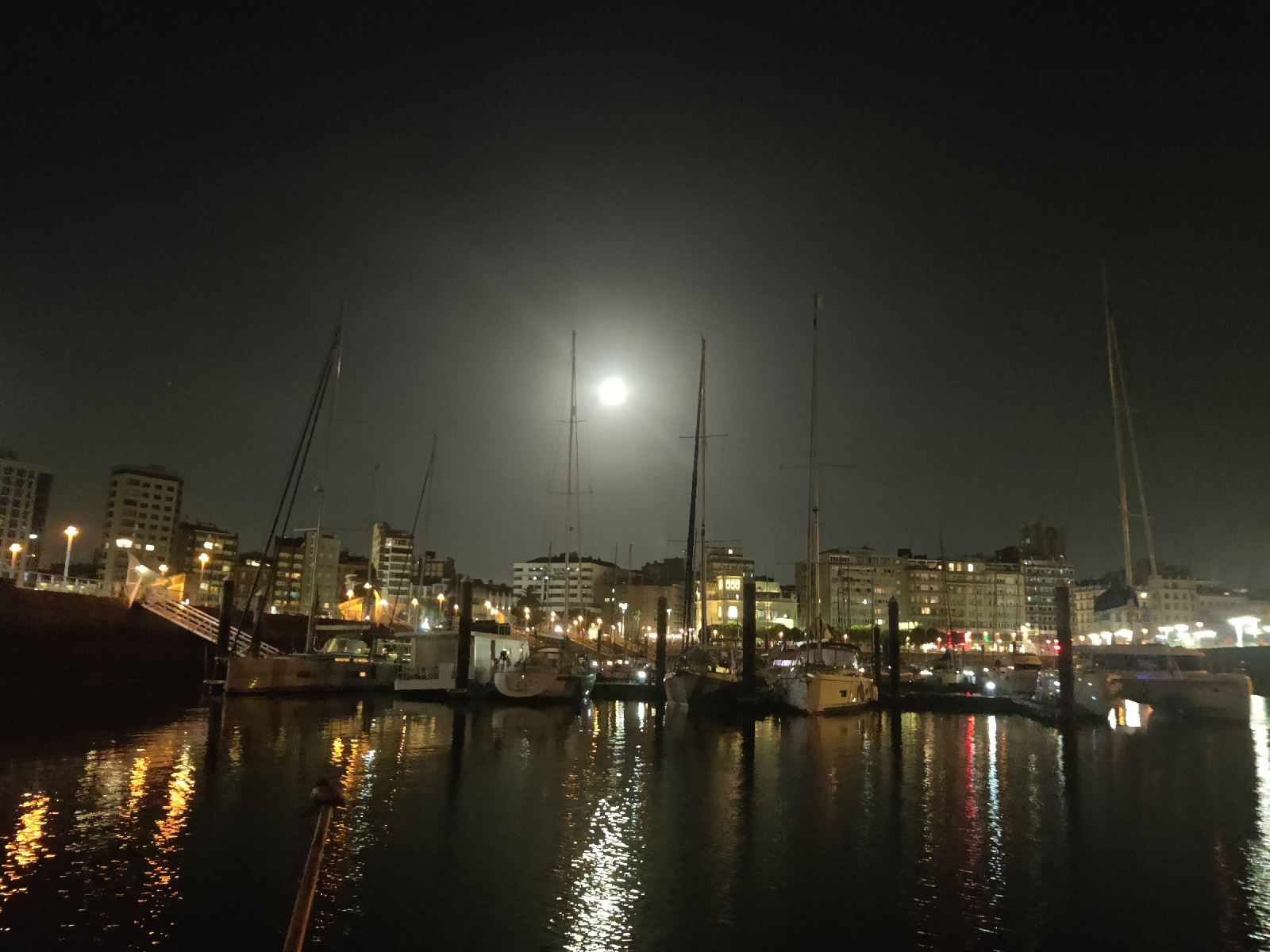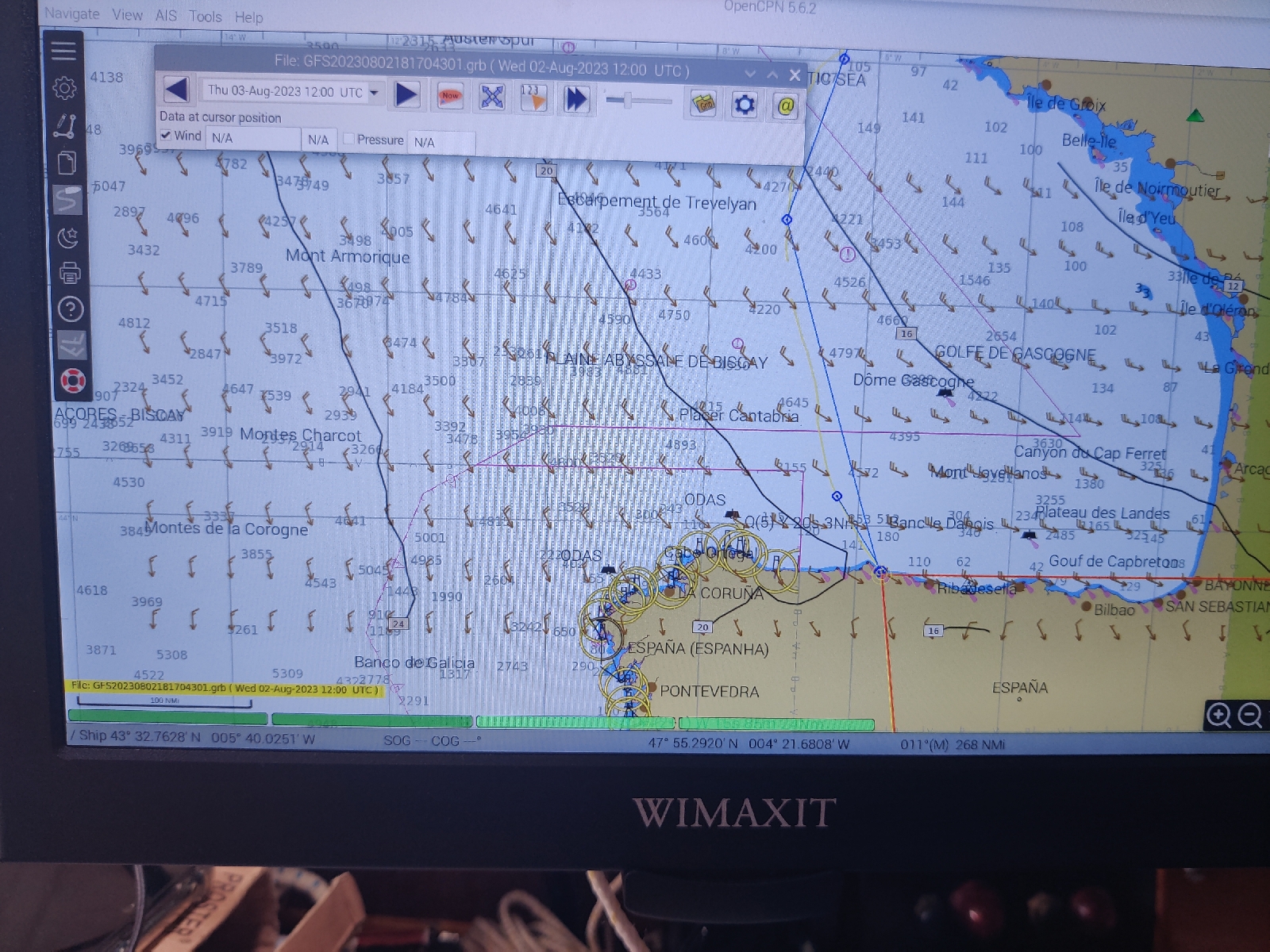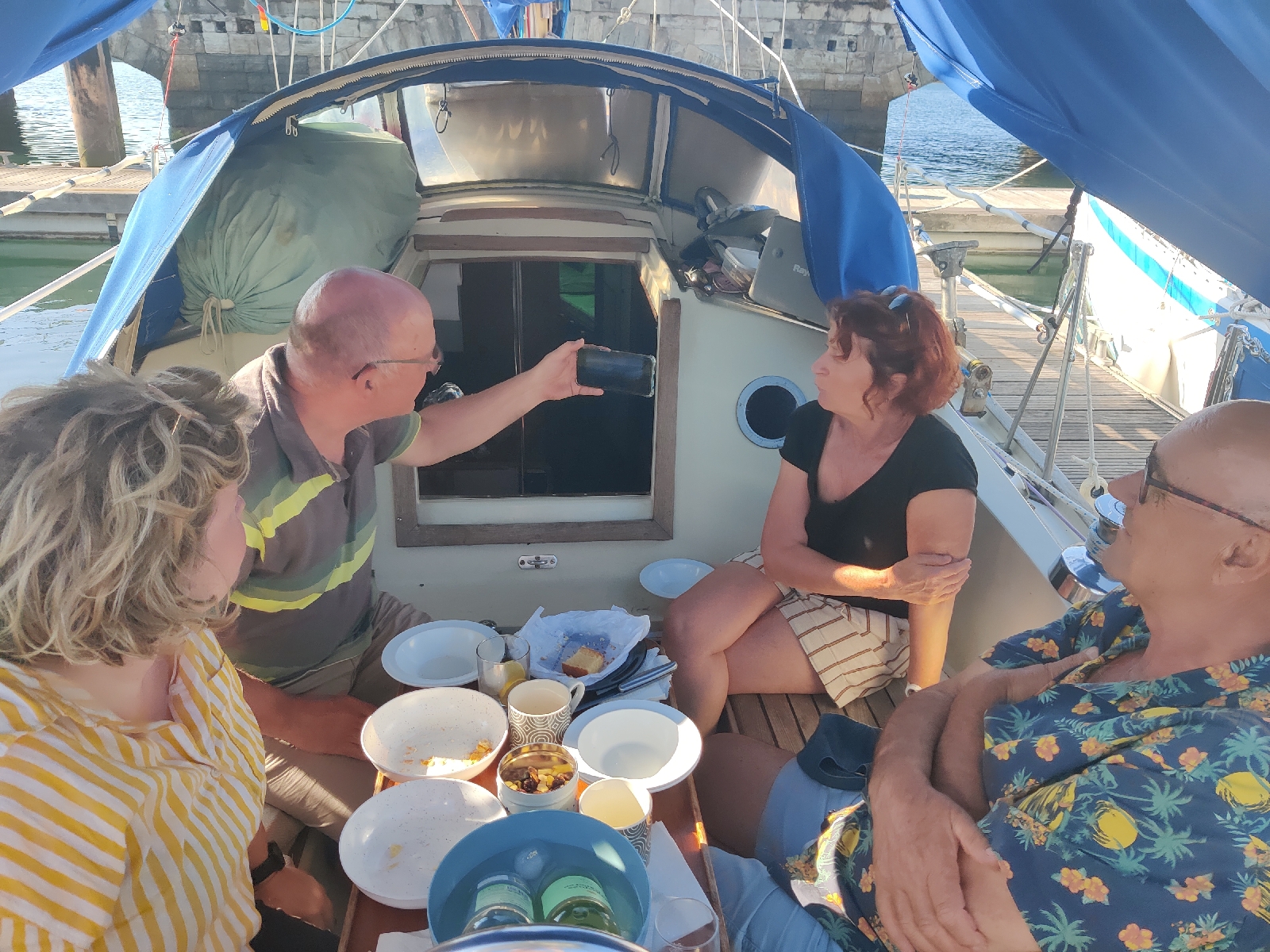Well we ended up spending a whole week in Gijon. Thankfully marina fees were half those we paid in Falmouth, nevertheless we need to cut down on such expenses.
After the excitement of the airshow over last weekend the town quietened down a little, but it was still pretty lively especially at night time.
Our main dilema has been and remains for now, what to do about the Hydrovane? We completed its removal from the stern by unbolting the heavy alloy brackets that were fastened to the stern, but we have not been able to complete the disassembly we started (perhaps unwisely in retrospect) because after some 45 years the stainless steel bolts that clamp the two heavy alloy brackets around the down tube are completely seized in place.
Nuts have come off (some have been damaged in the process) but the bolts themselves have so far resisted all attempts to shift them. Have we weakened the whole structure in the process? Is the ocean capable of loosening the bolts?
We are exploring two options. Firstly a further repair to the join of the hinge and the short shaft that enters the rudder and replacement of most of the main components of the Hydrovane. The issue of the seized bolts complicates both options. With the first if we cannot remove them and replace with new ones do we risk using them as is? With the second if we can't get them out, we can't reuse the brackets and will have to buy new ones, thereby making a hefty bill even heavier.
Asside from that, with respect to Option 1, can we get a strong enough repair made to ensure we don't experience yet another failure possibly in the middle of the Atlantic.
Option 2 will deliver complete re-assurance on that score and improved performance and ease of use over our existing system. The down side is the cost. It will make a very big hole in a budget already severely dented by the cost of living debacle.
Any way, as things stand in regard to the Hydrovane, we are now en route to Vigo, where, thanks to the very helpful Alberto, the Ocean Cruising Club's Port Officer there, a yard has been found that can help us. Once they have made a full assessment of the situation we will decide what to do.
Returning to our time in Gijon. The days seemed to fly by. We did get through a number of jobs, both old and new. Mick finally uncovered the mysteries of the satphone's apparent inability to make a connection to the weather data services - he needed to enter his iridium account details in the app, not the App account details!
Bizarrely the phone shows random numbers to the recipients it dials and one cannot get through on either its own number or the number it declares. Even more bizarrely it still manages to make the connection for the weather download. We are still awaiting a resolution to this aspect!
Anyway we now have a way of getting 'live' weather info via the Satphone and Router onto our mobile phone - or more accurately, onto Mick's because he has the Iridium 'account'. We will have to keep downloads to a minimum though because they are expensive. Mick bought £200 minutes of air time that apparently translates into 100 GB of data! So downloads need to be as small and as infrequent as practicable.
Getting that up and running is a big step forward but it would be even better if we could superimpose the weather data onto my Raspberry Pi navigation system 'OpenCPN'. To do that we need to connect the phone to the Pi via the wifi router and send the file of data. So with son Vincent's help, I got the necessary software installed on my phone and the Pi and after a lot of trial and error got it working. So when Mick downloads a weather file (they are called "GRIBS" - computer generated weather forecasts) he will send it to me via Bluetooth and over the wireless network to the Pi from where it can then be loaded and displyed over the chart by OpenCPN. Pretty cool.
Another success was getting our AIS working properly. It was not our doing but Pascal, our charming French neighbour in the marina for a couple of days who just happened to be something of a Ham Radio buff and new lots of useful stuff and had all the testing gear.
His laptop battery died before he could complete the testing but he said even before starting that he suspected a faulty cable/plug. No, no impossible I said, we have tried three different cables including one made-up professionally with plugs at both ends and all of them produce the same poor results so it must be something else! Then we remembered yet another cable we had recently unearthed and so we tried that just to show him. And what do you know? Perfect results! So, the old adage, "...if you've ruled out the impossible, the only things left are the possibles no matter how improbable" proved true once again. We had tried three seperate sets of cables and plugs, including one completely made up by a professional and they were all faulty. Unfortunately the one good one we had uncovered was too short to be of use.
The next day however Pascal returned with his testing kit and soldering iron and re-made the connection on one end of our installed cable that Mick had made (when routing new cable you need one end free of encumbrance in order to get it through ducts and holes etc). Success once again. We now had a properly functioning AIS. Pascal then proceeded to test our second new AIS antenna and pronounced it "kaput".
Now that we had the AIS working properly, I decided to try and get that data onto OpenCPN too. Fortunately the AIS unit has an inbuilt USB port for sending data to other devices. Equally fortunately I had a length of USB cable of just the right length and with the right profile plugs to physically connect the AIS unit to the Pi. Then it was more fiddling about with the software and after a while it was all working. So now we can see a graphical display of all transmitting vessels in range of our AIS antenna, on the electronic chart. That's pretty cool too.
If you click on the photo above to get a full size version you can make out green arrows at centre left. Those are boats in the local marina here at Ria de Ribadeo transmitting on AIS. The grey box to the right is the info displayed when one clicks on a 'target'. It's very handy when underway at sea to have that information all available in one place.
On Tuesday evening we invited Pascal and Marie and the all woman crew of 'Styx' for drinks. Only Pauline from Styx was able to join us that evening but we had a thoroughly enjoyabe time.
Pauline's English was excellent and Marie's too. Pascal's not so good but it was still infinitely better than my French! Pascal had a great sense of humour and we all enjoyed that. Pauline was leaving Styx the next day to go home. She told us they had a very bumpy Biscay crossing from La Rochelle at roughly the same time we crossed from Falmouth. Because they started from further East than us in broadly the same weather, their landfall was Santander - to the east of Gijon.
The following evening most of the rest of the crew including skipper Chloe, joined us for drinks. Chloe bought the boat, a Bavaria of around 40 feet, a couple of years ago, moved on board in La Rochelle and started preparing her for the voysge of her dreams. Ultimately she intends to go round the world. She has pulled together an all women crew - all new to eachother - and will circulate further crew over time. Her planned next stop is A Coruna then she'll take Styx to the Azores before the Canaries and Cape Verde, for the Atlantic crossing, so we're quite likely to meet up with her again in one or both of those locations.
We went shopping for provisions on Tuesday and again on Thursday. The Supermarket was doing a deal on Tankaray Gin and it was all I could do to stop Mick clearing the shelves.
Wednesday night and Thursday was the big blow. A full storm was raging further north in Biscay and it was wet and windy in Gijon. Styx broke a mooring line on Thursday morning and so Mick and I helped the crew move one berth across on the pontoons so that she was being blown onto a pontoon rather than off one.
We rounded off our stay in Gijon with a late evening provisioning trip (when Mick raided the Gin stocks) and then a late meal ashore.










No comments:
Post a Comment